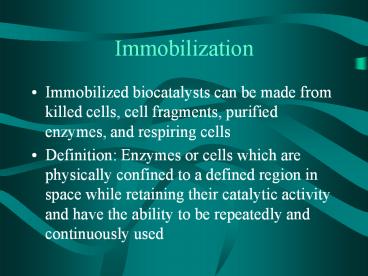Immobilization - PowerPoint PPT Presentation
1 / 21
Title:
Immobilization
Description:
... (polymer) common entrapment ... easily damaged than gel beads Other Membrane Immobilization Methods- HFM Hollow fiber reactors use micro- or ultra-filtration ... – PowerPoint PPT presentation
Number of Views:865
Avg rating:3.0/5.0
Title: Immobilization
1
Immobilization
- Immobilized biocatalysts can be made from killed
cells, cell fragments, purified enzymes, and
respiring cells - Definition Enzymes or cells which are physically
confined to a defined region in space while
retaining their catalytic activity and have the
ability to be repeatedly and continuously used
2
Advantages of Immobilization
- Higher dilution rates can be used in a CSTR.
- Easier product recovery.
- Lowered viscosity.
- Easier enzyme recovery.
- Why.
3
Disadvantages of Immobilization
- Mass transfer is inhibited
- Reduced activity of enzymes
- Bursting of immobilization medium due to cell
growth - Cells/enzymes can leak out of immobilization
medium
4
Immobilization Methods
Physical
Chemical
5
Membranes
6
Membrane Microencapsulation
- Membrane polymerized around aqueous enzyme
solution in colloidal suspension (particle sizes
on the order of 100-10 µm)
Add polymer
mixing
Organic solvent
Aqueous enzyme solution
7
Microencapsulation
- Advantages
- High surface to volume ratio
- Thin membrane
- Relatively benign attachment method
- Problems
- More easily damaged than gel beads
8
Other Membrane Immobilization Methods- HFM
- Hollow fiber reactors use micro- or
ultra-filtration membranes to retain high MW
enzymes, but pass low MW compounds
Substrate and products outside the membrane
Product diffuses out of the membrane
Enzymes or cells
Substrate diffuses through membrane
9
Close-up view of fiber
10
Hollow Fiber Reactor
Enzymes or cells in
Product out
Substrate in
11
Two Types of Cartridges
12
Entrapment
13
Entrapment
- Advantages
- Relatively benign attachment method
- Easy to perform
- Problems
- Mass transfer limitations
- Cell/enzyme leakage
- Some cell/enzyme deactivation
- Alginate (polymer) common entrapment matrix
14
Covalent Bonding
15
Covalent Bonding
- Most extensively used method of immobilization
due to high bond strength - Three elements- structural polymer, enzyme
molecule and bridge molecule - Activity of an immobilized enzyme is a strong
function of the hydrophilicity of the structural
polymer
16
Covalent Bonding To Support
- Bridging molecule needs to be small, have two
reactive groups, and not bond at the active site
17
Copolymerization of Enzymes
- Copolymerization is performed with
multifunctional bridge molecules to yield and
insoluble product - Usually an inert protein is also included
18
Chemistry of Covalent Immobilization
19
Adsorption
20
Immobilization by Adsorption
- Binding forces are ionic, hydrophobic, hydrogen
bonds, or Van der Waals interactions - Binding is simple (stir together in a beaker) but
is reversible. Substrate addition can cause
desorption.
21
Typical Adsorbents
- Cellulose
- Polystyrene resins
- Kaolinite
- Glass
- Alumina
- Silica gel

